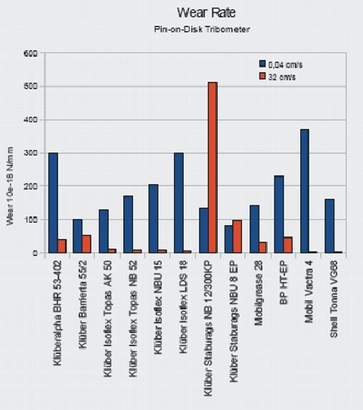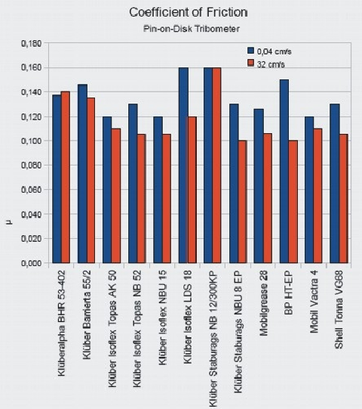Comparative Test of Lubricants Performed at CSEM / Neuchâtel
![[Translate to English:] Kontakt](/fileadmin/media/steinmeyer/kontakt.jpg)
Contact
Under +49(0)7431 1288-0 we are at your disposal.
Your desired size is not listed? We also manufacture individually. Give us a call!
On behalf of Steinmeyer and under the scope of a EUREKA project sponsored by the KTI (Commission for Technological Interchange) in Switzerland, the tribology lab of CSEM (Centre Suisse d'Electronique et Microtechnique) designed and conducted a test for commonly used lubricants under the specific tribological conditions found in ball screws.
A modified pin-on-disc tribometer was used, with the pin replaced by a regular bearing ball made from 52100 steel, which rode on a rotating disc made from the same material, heat treated and ground similar to the raceway of a ball screw. The disc and the ball closely resembled the friction partners in a ball nut in terms of material and surface finish.
Surface loads and relative speeds in two test series were selected to simulate a slow moving ball screw and a fast moving one. Since the pin-on-disc tribometer causes pure sliding instead of the sliding/rolling typical for a ball screw, the speeds were adjusted to the sliding portion of typical mid-size ball screw kinematics, running at about 50 rpm (0,04 cm/s in the tribometer) and at approximately 1000 rpm (32 cm/s in the tribometer). This simulated as closely as possible the real tribological conditions in a ball screw, both in terms of lubrication film build-up, and wear.
Results
First of all, the coefficient of friction does not seem to be correlated to the wear rate. Some lubricants yielded low friction, but higher wear at the same time!
- The wear rates of some greases show that these lubricants can really be seen as "universal", because they offer moderate wear protection at both slow and fast speeds.
- At the higher speed, both oils built a hydrodynamic lube film, which can be concluded from the extremely low wear rates.
- A plain mineral oil without wear-inhibiting additive (Vactra4) yielded excessive wear rate at slow speed, despite its high viscosity. It was obviously unable to protect the friction partners once speed fell below the threshold to build a hydrodynamic film. It was squeezed out of the contact patch and did not sufficiently reduce wear in boundary conditions.
- Oil with high-pressure, wear inhibiting additives (EP oil), which is able to bond its hydrocarbon molecules to metal surfaces through chemical or physical reaction, performs much better during conditions of boundary friction.
With the exception of a high-pressure grease, which caused the lube film to collapse at high speeds, all greases performed well and yielded acceptable wear rates throughout the test scenario. At the same time it was proven that greases are unable to build a perfect fluid film like oils of proper viscosity, so the wear rate with grease lubrication is higher than the wear rate of oil when an EHD film is present.




